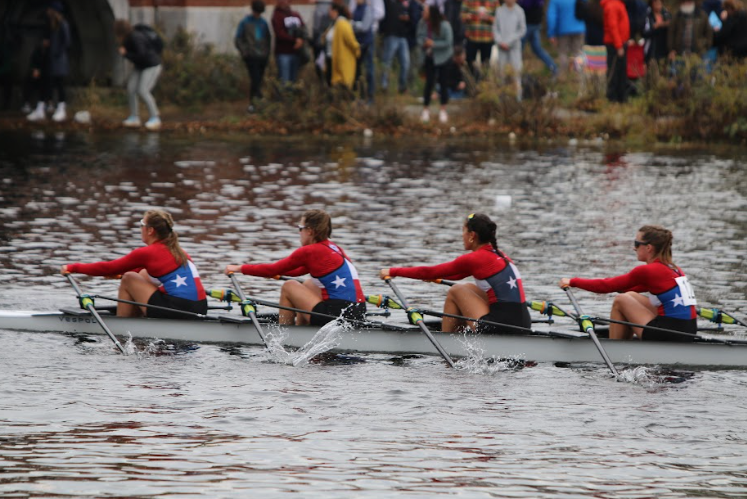The Extr-oar-dinary Talent of LASA Rower
ROWING TO SUCCESS Students Isabel Ueber and Marin Maycotte row in the Head of the Charles Regatta, a prestigious rowing event in Cambridge, Massachusetts. The regatta lasts from Oct. 20-22 and hosts over 400,000 spectators and 11,000 competitors. photos courtesy of Isabel Ueber and Marin Maycotte.
December 19, 2022
Two LASA juniors, Marin Macycotte and Isabel Ueber, headed to the prestigious rowing competition Head of the Charles Regatta in October, where they raced a 5000 meter course with over 400,000 spectators. With two racing seasons in fall and spring, the rowers put in hours into practicing during the summer and winter to hone their technique and stroke. Rigorous preparation gets them prepared for regattas, or rowing competitions, like the Head of the Charles Regatta.
Juniors Marin Maycotte and Isabel Ueber traveled to Boston, Massachusetts, in October to take part in the competition. According to Maycotte, the Head of Charles Regatta has competitors from all over the world competing at the site.
“The Head of the Charles is the biggest regatta that exists,” Maycotte said. “They have thousands of people from college and high school and masters too. The actual race was two days, but we only raced once since it was a longer course. We went on a Thursday, so we were there for four days. We practiced twice, and then the masters raced, and then we raced.”
The Head of Charles Regatta, can be quite selective about who they accept because it is such a huge event with participants traveling from all over the world. Over 700 different teams come and compete for a chance to go home with a medal, according to Ueber.
“It’s a pretty selective regatta just because you have to get bids for the next year which means that if you don’t get in the top half of the results, you don’t get bids for the next year,” Ueber said. “You just have to be near the top half of your team, and you’ll get invited.”
Like many other sports, rowing requires a great deal of time and traveling to partake in events. Schoolwork and other extracurricular activities may be affected by this, according to Ueber. She said that although the massive time requirement can be a downside to rowing, the results that are reaped from it can also be really beneficial.
“I’m planning on trying to get recruited for college,” Ueber said. “I think it’ll be helpful when they look at my races, and they’ll see that I went to Charles because it’s a pretty big regatta.”
Maycotte and Ueber row for the two different rowing centers in Austin. Maycotte is on a team at the Texas Rowing Center, and Ueber rows at the Austin Rowing Club. One of the coaches at the Texas Rowing Center, Anna Ohrstrom, said that rowing for a Division 1 (D1) team is what brought her newfound excitement after her try in other sports.
“When I was getting burnt out in competitive softball and basketball in high school, I discovered college rowing,” Ohrstrom said. “Colleges have novice teams on their rosters, which are to learn to row/first year rowers. I was recruited to be a novice rower. I rowed all four years as a D1 athlete at San Diego State University. I am letter winner, and two-year team captain.”
Ohrstrom now spends her full time coaching. She hopes that her efforts will help the next generation of rowers love the sport as much as does.
“I am providing opportunity and experience to the future generation of female athletes,” Ohrstrom said. “It allows me to provide to them what I received, but better.”
The end results of the regatta were exciting, according to both Maycotte and Ueber. Maycotte’s boat placed 16 out of 50 and they improved their time by 30 seconds compared to the past year. Ueber’s boat won second place and was just 13 seconds behind the boat that placed first. They both hope to continue their rowing careers as they get older.


